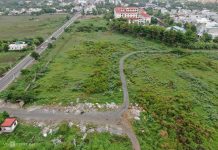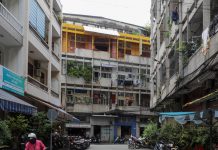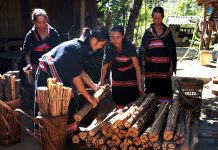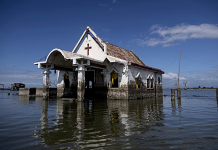How can a traveler get the most out of a trip to Can Tho City, considered the heart of the Mekong Delta? Read on.
Can Tho, a four hour-drive from Saigon, is one of Vietnam’s five cities, together with Hanoi, HCMC, Da Nang and Hai Phong, and has a history closely connected with the Hau River, a branch of the mighty Mekong River.
Not only is it a great starting point for those who want to explore the Mekong Delta’s floating markets, but also boasts distinctive foods and activities for travelers to explore.
The best time to visit Can Tho is during the flooding season between September and November. Here are some suggestions for first-time visitors to explore the city in less than 24 hours.
Getting to Can Tho
From Saigon, visitors can get to Can Tho by motorbike or car via the National Highway 1A. Budget travelers can take buses at Mien Tay Bus Station in Binh Tan District, or coaches with a one-way ticket price of VND130,000 ($5.6).
Cai Rang floating market (5 a.m.)
 |
People trade goods at the Cai Rang floating market on the Hau River. Photo by Shutterstock/Banana Republic Images. |
It goes without saying that a floating market has to be on the to-do list of any traveler to the Mekong Delta, and the biggest of all is the Cai Rang market in Can Tho.
Tourists will need to get a boat at Ninh Kieu Port to get to the market, which floats on the Hau River, about six kilometers from the city center. A boat ride costs VND30,000 ($1.3). If travelling in a group, you can rent a boat for VND350,000-400,000 ($15-17).
The 40-minute boat ride can be an amazing experience by itself as it passes houses built on stilts over the water and boats of all sizes, shapes and colors docked along the shore.
Though the market remains open until around 11 a.m. it is advisable for visitors to reach the place at 5-6 a.m. to avoid the scorching sun and to see the morning rush here as traders bring goods from farms through small canals.
Noodle soup for breakfast (8 a.m.)
 |
A bowl of bun goi da with noodles, shrimp, meat, and other ingredients. Photo by VnExpress/Phong Vinh. |
After heading back to Ninh Kieu Port, visitors can head to the local wet market to try one of the Mekong Delta’s lesser known foods, bun goi da.
The dish consists of noodles, shrimp, meat and others things one would normally see in a spring roll (goi cuon in Vietnamese). But apparently locals in Soc Trang, a province neighboring Can Tho, came up with another version by turning it into a soup dish using the same ingredients.
The broth has the refreshing flavor of tamarind and taste of tuong hot (a form of fermented soybean) that makes the dish different from the delta specialty, bun mam, that has broth made from fermented fish and shrimp paste.
In some places, locals add shredded coconut and balut (hot vit lon in Vietnamese) to make the dish even more special.
A bowl costs VND30,000 ($1.3).
Binh Thuy Ancient House (9 a.m.)
 |
Binh Thuy Ancient House on Bui Huu Nghia Street, Binh Thuy District, Can Tho City. Photo by VnExpress/Phong Vinh. |
The Binh Thuy Ancient House has earned the title of the prettiest old house in Can Tho for its unique look, with the exterior in European style and interior with traditional Vietnamese architecture.
Situated at 26/1A Bui Huu Nghia Street in Binh Thuy District, it was built by the Duongs, a well-respected family with a rich history of contribution to the country, in 1870 in French style.
It is now preserved by Duong Minh Hien, the sixth generation of the family.
Son Islet (11 a.m.)
 |
A tourist experiences fish farming on Son Islet in Can Tho City. Photo taken by VnExpress/Phong Vinh. |
After a meal, tourists can head to Son Islet (Con Son in Vietnamese) tourism area also in Binh Thuy District to get a glimpse of the life of local fishermen.
For just VND10,000 ($0.43), the trip offers visitors a chance to learn more about the raising and farming of various kinds of fish.
Tourists will also be able to feed the fish and observe how locals make snakehead fish “dance” as they jump above the water to catch the food.
To get to Son Islet, travelers will need to take a boat from Co Bac Port for VND5,000 ($0.22).
Regional specialties and tropical fruits for lunch (12 p.m.)
 |
A clay pot of braised fish. Photo acquired by VnExpress. |
After the fish farming tour, travelers can explore local cuisine without having to leave the islet.
There are many restaurants here and no matter which one they pick two dishes that cannot really go wrong for tourists are braised fish in clay pot and sesban soup.
Fish appears frequently on the locals’ day-to-day menu. One of the best ways to have a true taste of the Mekong Delta is by trying braised fish, which is marinated with spices in a clay pot over low heat, with white rice.
 |
A pot of sesban soup at a local restaurant in Can Tho City. Photo by VnExpress/Di Vy. |
Another highly recommended dish here is the sesban soup. Dien dien or sesban is a plant that grows near ponds, rivers and dykes and one which locals incorporate in their food since it offers a unique aromatic texture and subtle fatty taste.
People make a soup with its flowers by cooking it with different kinds of fish, including catfish and perch.
 |
A variety of fruits at an orchard in Can Tho City. Photo by VnExpress/Phong Vinh. |
While on the islet, visitors can stop by a fruit orchard to sample some of Southeast Asia’s exotic tropical fruits such as durian, rambutan, mangosteen, and guava. For around VND60,000 ($2.60), a visitor can walk around and take photos and pick fruits. They can also buy some to take back as gifts.
Most orchard owners have built walkways with bricks and stones so that guests can access all parts. While they tour an orchard, the owner will tell guests about their trees and fruits.
Bang Lang stork garden (2 p.m.)
 |
Bang Lang stork garden is home to thousands of storks and many other kinds of birds. Photo courtesy of Can Tho Tourism Department. |
After lunch travelers can spend the afternoon exploring Bang Lang stork garden, an ideal location to get some quiet time amid nature and away from the bustle of city life.
Situated 52 kilometers from the city, the sanctuary is home to thousands of storks as well as many other kinds of birds. The best time to visit is from August to January, the breeding season, when tens of thousands of storks come and nest.
Travelers should stay here to watch the sunset and witness the sight of hundreds of storks of various sizes coming back to roost.
Traditional family meal for dinner (6:30 p.m.)
 |
Hoi Do restaurant’s decor harks back to a bygone era. Photo by VnExpress/Ha Thanh. |
To recharge after a long day, travelers can head to Hoi Do restaurant, meaning ‘back then’, to get a glimpse of the life of southern people in the 1980s. The restaurant is on Tran Binh Trong Street in Ninh Kieu District and has a decor harking back to a bygone era.
 |
Hoi Do restaurant in Can Tho City has many southern dishes that are served family-style for sharing. Photo by VnExpress/Phong Vinh. |
Each dish here costs around VND40,000 ($1.7). In a group each visitor could expect to pay VND70,000-100,000 ($3-4.3) since the restaurant will increase the portion according to the number of people.
It has 30 southern dishes that will be served family-style and shared communally.































